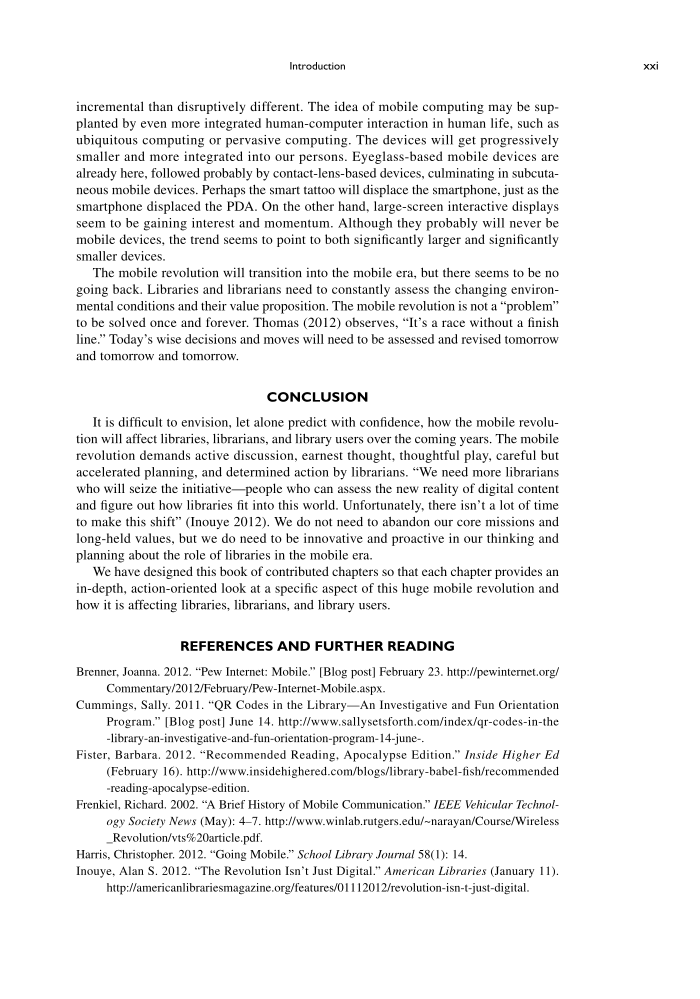incremental than disruptively different. The idea of mobile computing may be sup- planted by even more integrated human-computer interaction in human life, such as ubiquitous computing or pervasive computing. The devices will get progressively smaller and more integrated into our persons. Eyeglass-based mobile devices are already here, followed probably by contact-lens-based devices, culminating in subcuta- neous mobile devices. Perhaps the smart tattoo will displace the smartphone, just as the smartphone displaced the PDA. On the other hand, large-screen interactive displays seem to be gaining interest and momentum. Although they probably will never be mobile devices, the trend seems to point to both significantly larger and significantly smaller devices. The mobile revolution will transition into the mobile era, but there seems to be no going back. Libraries and librarians need to constantly assess the changing environ- mental conditions and their value proposition. The mobile revolution is not a “problem” to be solved once and forever. Thomas (2012) observes, “It’s a race without a finish line.” Today’s wise decisions and moves will need to be assessed and revised tomorrow and tomorrow and tomorrow. CONCLUSION It is difficult to envision, let alone predict with confidence, how the mobile revolu- tion will affect libraries, librarians, and library users over the coming years. The mobile revolution demands active discussion, earnest thought, thoughtful play, careful but accelerated planning, and determined action by librarians. “We need more librarians who will seize the initiative—people who can assess the new reality of digital content and figure out how libraries fit into this world. Unfortunately, there isn’t a lot of time to make this shift” (Inouye 2012). We do not need to abandon our core missions and long-held values, but we do need to be innovative and proactive in our thinking and planning about the role of libraries in the mobile era. We have designed this book of contributed chapters so that each chapter provides an in-depth, action-oriented look at a specific aspect of this huge mobile revolution and how it is affecting libraries, librarians, and library users. REFERENCES AND FURTHER READING Brenner, Joanna. 2012. “Pew Internet: Mobile.” [Blog post] February 23. http://pewinternet.org/ Commentary/2012/February/Pew-Internet-Mobile.aspx. Cummings, Sally. 2011. “QR Codes in the Library—An Investigative and Fun Orientation Program.” [Blog post] June 14. http://www.sallysetsforth.com/index/qr-codes-in-the -library-an-investigative-and-fun-orientation-program-14-june-. Fister, Barbara. 2012. “Recommended Reading, Apocalypse Edition.” Inside Higher Ed (February 16). http://www.insidehighered.com/blogs/library-babel-fish/recommended -reading-apocalypse-edition. Frenkiel, Richard. 2002. “A Brief History of Mobile Communication.” IEEE Vehicular Technol- ogy Society News (May): 4–7. http://www.winlab.rutgers.edu/~narayan/Course/Wireless _Revolution/vts%20article.pdf. Harris, Christopher. 2012. “Going Mobile.” School Library Journal 58(1): 14. Inouye, Alan S. 2012. “The Revolution Isn’t Just Digital.” American Libraries (January 11). http://americanlibrariesmagazine.org/features/01112012/revolution-isn-t-just-digital. Introduction xxi
Document Details My Account Print multiple pages
Print
You have printed 0 times in the last 24 hours.
Your print count will reset on at .
You may print 0 more time(s) before then.
You may print a maximum of 0 pages at a time.

















































































































































































































































